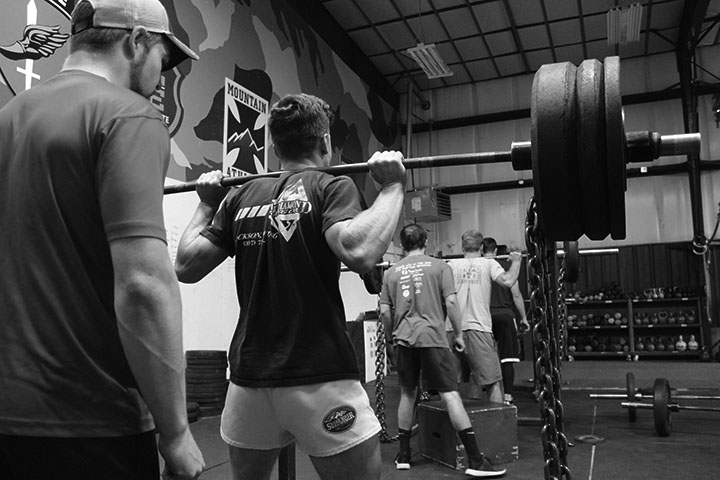
By Rob Shaul
BLUF
Experienced MTI Lab Rats showed nearly 10% strength gain over 3 strength exercises following Big 24 strength progression for 3 weeks. Men gained more strength than women during the short cycle.
Background
I’m frequently asked by athletes how much strength gain they can expect completing one of our strength-focused programs. My standard answer is 10-20% depending upon the “training age” of the athlete.
“Training Age” is not the individual athlete’s actual age, but rather his or her year’s of experience strength training in the weight room. I’m 50 years old, have been lifting weights since I was 14, so my current training age is 36.
However, if I’d been an endurance athlete rather than a meathead, it is entirely possible that I wouldn’t have touched a barbell until age 48. If that was the case my “training age” would be just 2.
In general, the higher training age, the closer the athlete is to his or her genetic strength potential and thus the less he or she will gain in strength from anyone strength progression.
Likewise, the lower the training age, the further the athlete is from his or her genetic strength potential, and thus the more he or she will see in strength gains from any progression.
This mini-study sought to assess strength gain for high training age athletes over 3 weeks of Big 24 progression.
The power of Big 24 comes through these exercises and a simple but aggressive progression. The name “Big 24” is derived from the number of total reps (24 reps) you will perform for lower and upper body strength exercises during the training sessions.
Instead of working up to 1RM, in Big 24 athletes work up to 3RM – or 3x repetition maximum for classic Lower and Upper body barbell-based strength exercises. Athletes work up to 2RM – 2x repetition maximum for Total Body strength exercises.
Follow-on set rep schemes are 8 Rounds of 3 reps (8×3 – 24, hence the name) for Lower and Upper body strength exercises, and 9 rounds of 2 reps for Total Body Exercises.
In the first follow-on progression, the athlete drops 10# from his/her 3RM (or 2RM) and completes rounds 4-8 at that load (5 Rounds total). In the second progression, the athlete drops just 5# from his/her 3RM and completes rounds 4-8 at that load. In the final progression, the athlete completes rounds 4-8 at his/her 3RM… then they re-assess and start the progression all over again.
MTI’s “Big 24” progression is one of our oldest, and anecdotally, most successful, and we’ve applied the progression scheme to several different exercises of the years.
This short, 3-week Lab Rat cycle deployed three exercises, trained twice each week: Hang Squat Clean (Total), Incline Bench Press (Upper) and Box Squat (Lower).
Athletes trained Big 24 (these three exercises) two times each week – Monday and Wednesday. On Tuesday’s and Thursdays they ran endurance intervals – either 1 mile or 2-mile running repeats. Here was the weekly schedule and below a chart showing the progression:
- Monday: Big 24 Progression (Hang Squat Clean, Incline Bench Press, Box Squat)
- Tuesday: Run interval repeats (1 or 2 mile)
- Wednesday: Big 24 Progression (Hang Squat Clean, Incline Bench Press, Box Squat)
- Thursday: Run interval repeats (1 or 2 mile)
Typically, we’ll run the Big 24 progression over a 6-week cycle, with a mid-cycle re-assessment, and a final re-assessment the first day of Week 7.

Results/Discussion
See the chart below for results from this cycle:

Over the years, we’ve seen between 10-20% overall strength gains using Big 24 progression over the course of a 6-7 week cycle, depending upon the training age of the athlete.
All the athletes in this mini-study were veteran MTI Lab Rats, with a relatively high training age, and the results after 3 weeks are in line with what we’ve seen anecdotally for a 6-week cycle.
Note the difference in results between male and female athletes. Overall, the three female athletes in the study improved less, and there was no improvement for the female athletes in the one upper body exercise, the Incline Bench Press. This is also not unusual for what we’ve experienced anecdotally over the years.
In general, women see less strength gain compared to men for the same progression, and this is accentuated for upper body strength. This has been a frustrating outcome for us over the years that we have not yet found a solution for. In a past mini study, we’ve actually compared two types of programming based on volume and intensity for female athletes to see if one performed better.
While there are obvious physical and maximal strength differences between men and women, we’re not sure why women wouldn’t also respond as well to the same programming. We have work to do.
Next Steps
This mini-study evaluated just a short, 3-week cycle deploying Big 24 across three exercises. For a full cycle, we would have used the second assessment as a mid-cycle assessment, and begun the progression again for three more weeks, with a final re-assessment on week 7. We would expect to see further gains, though not as great as those achieved the first 3 weeks.
Ultimately, it would be instructive to conduct similar mini-studies on MTI’s six other strength progressions and compare the results across the board. This could perhaps identify which of MTI’s seven strength progressions is the most effective for experienced athletes.
Questions, Comments, Feedback? Email rob@mtntactical.com
You Might Also Like MTI’s Big24 Strength Training Plan
